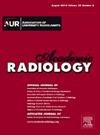Radiological features on high-resolution MR imaging predicts successful recanalization in patients with symptomatic chronic intracranial large artery occlusion
IF 3.8
2区 医学
Q1 RADIOLOGY, NUCLEAR MEDICINE & MEDICAL IMAGING
引用次数: 0
Abstract
Rationale and Objectives
Endovascular recanalization has been attempted in patients with symptomatic chronic intracranial large artery occlusion (CILAO), however, the heterogeneity of recanalization outcomes present challenges for the clinical application.
Objective
To determine the radiological features on high-resolution MR imaging (HR-MRI) for predicting successful recanalization of symptomatic CILAO.
Methods
Seventy-three patients with symptomatic CILAO who underwent endovascular recanalization at our center were retrospectively analyzed. Patients’ clinical information, HR-MRI characteristics, procedural results, and outcomes were recorded. Factors related to successful recanalization were analyzed by univariate and multivariate analyses.
Results
Technical success was achieved in 61 (83.6%) patients, with a complication rate of 13.7% (10/73). Based on multivariate analysis, responsible occluded artery (middle cerebral artery (MCA) trunk versus intracranial internal carotid artery (ICA), P = 0.004; MCA trunk versus intracranial vertebrobasilar artery (VBA), P = 0.010), occlusion with residual lumen (P = 0.036), occlusion with marked plaque enhancement (P = 0.011), and shorter occlusion length (≤10.2 mm versus >10.2 mm, P = 0.008) were identified as independent positive predictors of successful recanalization. Patients were assigned score points according to the coefficients of the prediction model, and the technical success rates were 50.0%, 83.3%, 95.5%, and 100% in patients with score ≤ 2, 3, 4, and ≥ 5 points, respectively.
Conclusions
The HR-MRI modality may be valuable in identifying candidates for endovascular recanalization of symptomatic CILAO. MCA trunk occlusion, occlusion with residual lumen, occlusion with marked plaque enhancement and shorter occlusion length on HR-MRI appear to be significantly associated with the success of recanalization.
高分辨率磁共振成像的放射学特征可预测无症状慢性颅内大动脉闭塞患者能否成功再通。
理由和目标:有症状的慢性颅内大动脉闭塞(CILAO)患者已经尝试过血管内再通术,然而,再通术结果的异质性给临床应用带来了挑战:目的:确定高分辨率磁共振成像(HR-MRI)预测症状性慢性颅内大动脉闭塞再通成功的放射学特征:方法:对在本中心接受血管内再通术的73例症状性CILAO患者进行回顾性分析。记录了患者的临床信息、HR-MRI特征、手术结果和预后。通过单变量和多变量分析,对成功再通的相关因素进行了分析:61例(83.6%)患者获得了技术成功,并发症发生率为13.7%(10/73)。根据多变量分析,责任闭塞动脉(大脑中动脉(MCA)干与颅内颈内动脉(ICA),P = 0.004;MCA干与颅内椎-基底动脉(VBA),P = 0.P=0.010)、有残余管腔的闭塞(P=0.036)、有明显斑块强化的闭塞(P=0.011)和较短的闭塞长度(≤10.2 mm 与 >10.2 mm,P=0.008)被确定为成功再通的独立积极预测因素。根据预测模型的系数对患者进行评分,评分≤2分、3分、4分和≥5分的患者的技术成功率分别为50.0%、83.3%、95.5%和100%:结论:HR-MRI 模式在确定有症状的 CILAO 的血管内再通术候选者方面可能很有价值。HR-MRI显示的MCA主干闭塞、闭塞伴有残腔、闭塞伴有明显斑块强化以及较短的闭塞长度似乎与再通的成功率显著相关。
本文章由计算机程序翻译,如有差异,请以英文原文为准。
求助全文
约1分钟内获得全文
求助全文
来源期刊

Academic Radiology
医学-核医学
CiteScore
7.60
自引率
10.40%
发文量
432
审稿时长
18 days
期刊介绍:
Academic Radiology publishes original reports of clinical and laboratory investigations in diagnostic imaging, the diagnostic use of radioactive isotopes, computed tomography, positron emission tomography, magnetic resonance imaging, ultrasound, digital subtraction angiography, image-guided interventions and related techniques. It also includes brief technical reports describing original observations, techniques, and instrumental developments; state-of-the-art reports on clinical issues, new technology and other topics of current medical importance; meta-analyses; scientific studies and opinions on radiologic education; and letters to the Editor.
 求助内容:
求助内容: 应助结果提醒方式:
应助结果提醒方式:


